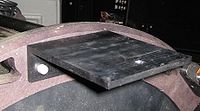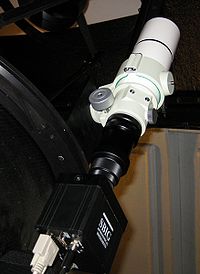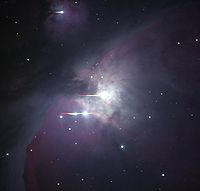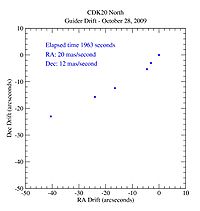Difference between revisions of "Guider"
| Line 1: | Line 1: | ||
The CDK20 | The CDK20 telescopes at Moore and Mt. Kent Observatories were moved to Planewave A200HR mounts in the fall of 2010. These systems provide high resolution encoders and eliminate periodic error so that optical guiding is no longer needed. | ||
Prior to that, the Celestron CDK20 mounts limited exposure time without guiding to about 20 seconds because of periodic and occasional aperiodic errors of the order of 10 arcseconds. During the development of the Shared Skies project several methods were used to work around the tracking problems, including adding short exposures, autoguiding the SBIG dual CCD cameras, driftscan imaging and, most successfully external autoguiders. The first of these was the classic SBIG STV which turned out to be very cumbersome to use remotely. The second and last was an SBIG SG-4 autoguider added to the Moore Observatory CDK20 in October 2009. Plans to put an SG-4 on the Mt. Kent telescope were abandoned when the A200HR mounts were ordered in 2010. | |||
The CDK20 north SG-4 was mounted on the bracket originally designed to hold a Nikon DSLR and wide-field lens under the telescope. However, in that position, the guider would not clear the mount as the telescope rotated in declination. The bracket was moved to the "top" of the telescope and secured to the central truss ring by two 1/4-20 stainless steel allen-head cap screws. The Nikon attachment plate has a rib on the underside that reduced but did not fully eliminate flexure. | The CDK20 north SG-4 was mounted on the bracket originally designed to hold a Nikon DSLR and wide-field lens under the telescope. However, in that position, the guider would not clear the mount as the telescope rotated in declination. The bracket was moved to the "top" of the telescope and secured to the central truss ring by two 1/4-20 stainless steel allen-head cap screws. The Nikon attachment plate has a rib on the underside that reduced but did not fully eliminate flexure. | ||
Revision as of 06:06, 16 April 2012
The CDK20 telescopes at Moore and Mt. Kent Observatories were moved to Planewave A200HR mounts in the fall of 2010. These systems provide high resolution encoders and eliminate periodic error so that optical guiding is no longer needed.
Prior to that, the Celestron CDK20 mounts limited exposure time without guiding to about 20 seconds because of periodic and occasional aperiodic errors of the order of 10 arcseconds. During the development of the Shared Skies project several methods were used to work around the tracking problems, including adding short exposures, autoguiding the SBIG dual CCD cameras, driftscan imaging and, most successfully external autoguiders. The first of these was the classic SBIG STV which turned out to be very cumbersome to use remotely. The second and last was an SBIG SG-4 autoguider added to the Moore Observatory CDK20 in October 2009. Plans to put an SG-4 on the Mt. Kent telescope were abandoned when the A200HR mounts were ordered in 2010.
The CDK20 north SG-4 was mounted on the bracket originally designed to hold a Nikon DSLR and wide-field lens under the telescope. However, in that position, the guider would not clear the mount as the telescope rotated in declination. The bracket was moved to the "top" of the telescope and secured to the central truss ring by two 1/4-20 stainless steel allen-head cap screws. The Nikon attachment plate has a rib on the underside that reduced but did not fully eliminate flexure.
The guider was used a Takahashi 60 mm diameter apochromatic refractor with a focal length of 355 mm. The assembly was held by a Takahashi tube mount, and bolted to the Nikon plate with a single 1/4-20 screw. The strength of this attachment derived from the large contact area.
The SG-4 requires a serial connection to the control computer and 12V DC power. On the Moore telescope, the 12V was supplied by a powerbrick that was carried on the OTA and connected to the web powerswitch "Camera" control. The serial line was connected through a DB9 and 6-foot serial extension cable to a Cat5 cable with DB9 adapters that went to pegasus, the Sirius dome computer.
Pegasus runs with a Siig PCI serial card that adds two ports to the machine. These ports appear as ttyS4 and ttyS5. (To see the port assignments, use dmseg | less and search for tty.) On the Moore telescope in 2009 the ttyS5 port was used for the guider connection. This default was set in the prefs.guider file that was installed with our xmguider software.
The guider in this location tracked with an accuracy of at least 1.5 arcseconds full width at half maximum in 60 second exposures. One of the first images taken with this system was the one of M42 on the night of October 28-29, 2009, and shown here.
The external guider still presented several problems, especially in autonomous use. The primary one limiting ultimate image quality was taht there was flexure in the guider mount that caused a drift of the axis of the SG-4 with respect to the CDK20 with changing orientation of the telescope. When the images of M42 were recorded, this flexure progressed linearly in both declination and right ascension at a rate of the order of 15 milliarcseconds per second. In the example below, the OTA was on the west side of the pier pointing southeast, with Orion at azimuth approximately 120 degrees. In this orientation the "x" and "y" axes of the guider were rotated to the vertical and the changing load apparently was sufficient to twist the guider axis. A plot of the accumulated pointing error is shown in the figure.
Partly because of flexure and because of the varying corrections required at different pointings and pier sides, the SG-4 required frequent recalibration. The process could be initiated in software, but was more likely to be successful when an operator could monitor the device locally.
The SG-4 autoguider experiment ended in the spring of 2010 with the decision to replace the mountings on both telescopes.



